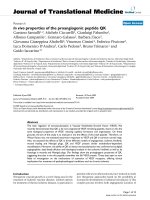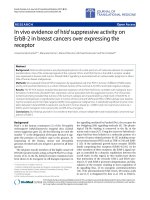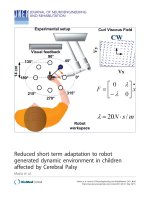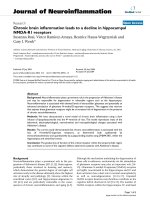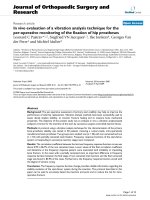Báo cáo hóa học: " In situ Precursor-Template Route to Semi-Ordered NaNbO3 Nanobelt Arrays" pptx
Bạn đang xem bản rút gọn của tài liệu. Xem và tải ngay bản đầy đủ của tài liệu tại đây (984.75 KB, 8 trang )
NANO EXPRESS Open Access
In situ Precursor-Template Route to Semi-Ordered
NaNbO
3
Nanobelt Arrays
Junshu Wu, Dongfeng Xue
*
Abstract
We exploited a precursor-template route to chemically synthesize NaNbO
3
nanobelt arrays. Na
7
(H
3
O)Nb
6
O
19
·14H
2
O
nanobelt precursor was firstly prepared via a hydrothermal synthetic route using Nb foil. The aspect ratio of the
precursor is controllable facilely depending on the concentration of NaOH aqueous solution. The precursor was
calcined in air to yield single-crystalline monoclinic NaNbO
3
nanobelt arrays. The proposed scheme for NaNbO
3
nanobelt formation starting from Nb metal may be extended to the chemical fabrication of more niobate arrays.
Introduction
One-dimensional (1D) nanostructures are receiving an
ever-increasing amount of attention from researchers in
various disciplines because of their unusual quantum
properties to their bulk counterparts and potential use
as building blocks for the next generation of nanoscale
optical, electronic, photonic, and biological devices [1,2].
Ordered functional arrays or chemically defined surfaces
with fascinating quantum behaviour are more attractive
nanostructures owing to their applications in high-
density memories, sensors, lasers, and photonic crystals.
Although numerous efforts have been invested in devel-
oping simple and low-cost fabrication techniques for the
growth of high-quality 1D materials in a relatively large
scale [3-10], the ability to fabricate ordered 1D micro-
and nanostructures in a desired pattern with controlla-
blesizeandshapeuniformityisakeychallengein
enabling their improved technological applications and
has opened up the minds of new generation of materials
scientists about the potential of nanoscience and tech-
nology [11,12].
Alkalineniobatesisoneclassofwidelyinvestigated
ternary materials because of their optical, ferroelectric,
and piezoelectric properties [13-19]. To date, many
niobium-co ntaining pe rovskite materials have been
synthesized through various kinds of methods and exhi-
bit wide applications in nonlinear optics, pyroelectric
detectors, and optical memories, etc. NaNbO
3
belong s to
a technologically important group of perovskite materi-
als, which comprises a three-dimensional framework of
corner-sharing NbO
6
octahedra with Na cations oc cupy-
ing their cavities [20-22]. Tilting of NbO
6
octahedra at
different temperature brings different phases (ortho-
rhombic, monoclinic, and cubic phase). Generally, the
shape of crystalline particles depends on their internal
structures [23]. This means that materials with a cubic or
pseudocubic structure will normally form isotropic parti-
cles in a thermodynamic decided process. Actually, till
now there are few reports about high aspect ratio 1D
NaNbO
3
micro/nano structures, which provide a good
system to study the size and dimensionality dependences
of the physical properties. Herein, we exploit a facile
precursor-template route to chemically fabricate
NaNbO
3
nanobelts. After a solid-phase transformation of
Na
7
(H
3
O)Nb
6
O
19
·14H
2
O precursors in air, semi-ordered
NaNbO
3
nanobelt arrays were yielded without morphol-
ogy deformation. In this proposed scheme, the aspect
ratio and uniformity of the precursor and NaNbO
3
nano-
belts are controllable. Low concentration of NaOH in
this process also avoids strong corrosive effect.
Experimental
A typical synthesis was performed as follows. A piece of
Nb foil (6 × 6 × 0.5 mm) was pretreated by sonication
in ethanol for 10 min and laid flat in a Teflon-lined
stainless steel autoclave (capacity, 30 mL). Twenty milli-
litres 1.0 M NaOH solution mixed with 3 mL H
2
O
2
(PH = 13.2) was then filled into the autoclave that was
sealed and put into an electric oven. T he concentration
of NaOH was changed from 0.5 to 1.5 M to tune the
* Correspondence:
State Key Lab of Fine Chemicals, Department of Materials Science and
Chemical Engineering, School of Chemical Engineering, Dalian University
of Technology, Dalian 116012, China.
Wu and Xue Nanoscale Res Lett 2011, 6:14
/>© 2010 Wu and Xue. This is an Open Access article distributed under the terms of the Creative Commons Attribution Lice nse
( censes/by/2.0), which permits unrestricted use, distribution, and reproduction in any medium, provided
the origina l work is properly cited.
aspect ratio of precursor nanobelts. The temperature o f
the electric oven was set at 150– 220°C and kept the
reaction lasted for 10–24 h under autogenous pressure.
After the autoclave was air-cooled to room temperature,
Nb foil was dissolved completely, and the white sheet-
like powders were collected, rinsed with deionized
water, and dried at 40–60°C for 2–5 h in air. NaNbO
3
nanobelt arrays could be obtained by calcining the pre-
cursor at 500–550°C for 1–4h.
The as-prepared samples were characterized by an X-ray
diffractometer (XRD) on a Rigaku-DMax 2400 diffract-
ometer equipped with the graphite monochromatized Cu
Ka radiation flux at a scanning rate of 0.02°/s in the 2θ
range 5–80°. Scanning electron microscopy (SEM) images
were taken with a JEOL-5600LV scanning electron micro-
scopy, using an accelerating voltage of 20 kV. Energy-
dispersive X-r ay (EDX) microanalys is of the samples was
performed during SEM measurements. The structures
were investigated by transmission electron microscopy
(TEM, Philips, Tecnai G220, operated at 200 kV).
Thermogravimetric analysis and differential scanning
calorimetry (TG/DSC, SDT Q600, TA) were employed
to analyse the thermal behaviours of the synthesized pre-
cursor in N
2
atmosphere at a heating rate of 10°C/min.
UV–vi sible (U V– Vis) spectra of the samples were mea-
sured on a UV– Vis-NIR spectrophotometer (JASCO-
V570). The photoluminescence (PL) spectra were
measured at room temperature in the range of 310–
700 nm using a Xe lamp with a wavelength of 290 nm as
the excitation source. The infrared (IR) spectrum was
measured by KBr pellet method (using a Nicolet NEXUS
infrared spectroscopy) in the range of 400–4,000 cm
-1
.
Results and Discussion
Hydrothermal technique has been most popular and
widely used in the synthesis of advanced materials of dif-
ferent disciplines owing to its advantages in terms of high
reactivity of reactants, formation of metastable and
low energy consumption. In our scheme, Na
7
(H
3
O)
Nb
6
O
19
·14H
2
O nanobelts were firstly synthesized under
mild hydrothermal conditions. XRD pattern of the
obtained product is shown in Figure 1a. The major diffrac-
tion peaks can be indexed as the Na
7
(H
3
O)Nb
6
O
19
·14H
2
O
with an orthorhombic lattice (JCPDS card no. 84-0188).
The broad diffractive peaks are attributed to the nanosize
of the sample. Moreover, a characteris tic diffraction peak
from remnant Nb foil is detected. The molecular structure
of Na
7
(H
3
O)Nb
6
O
19
·14H
2
O is further supported by the
solid-state IR spectrum (Figure 1b), which is in agreement
with the literature values [24].
It has been reported that as the concentration of AOH
(A = Na, K) increases in solution, the Lindquist
ANbO
8619
8
+
−
[]
compound is salted out as a major product
[25]. In each Lindquist ion of Na
7
(H
3
O)Nb
6
O
19
·14H
2
O,
six NbO
6
octahedra compose a bigger octahedron by shar-
ing edges, Na atoms are scattered within the vacancies
between the Lindquist octahedral sites. Further examina-
tion of the crystal structure of Na
7
(H
3
O)Nb
6
O
19
·14H
2
O
reveals that the preferential orientation of the Na
7
(H
3
O)
Nb
6
O
19
·14H
2
Oisalongc-axis. Consideri ng that no tem-
plates and surfactants are used, it is the internal crystal
structure that induces 1D growth of the Lindquist compo-
site. Because of the coexistence of H
2
O
2
and NaOH, alka-
line oxidant solution is formed in the autoclave. The metal
substrate is oxidated continuously by H
2
O
2
into Nb
2
O
5
which is subsequently dissolved by NaOH. Metastable
phases often crystallize first at low temperature because
their nucleolus may require lower free energy and lower
supersaturation t o form in the nucleation-controlled
regime. Therefore, Na
7
(H
3
O)Nb
6
O
19
·14H
2
O is crystallized
and precipitated out of the solution.
The low-magnification SEM images of Na
7
(H
3
O)
Nb
6
O
19
·14H
2
O (Figure 2a, b) have been taken from ran-
dom ly selected areas, and as such, these are representa-
tive of the overall sizes and shapes in the samples. It is
seen that ultralong Na
7
(H
3
O)Nb
6
O
19
·14H
2
O nanobelt
arrays are with honeycomb-like micropattern s. The
length is in micrometer range. Furthermore, the high-
magnification SEM images in Figure 2c, d reveal that
these nanobelts are formed uniformly and compactly
with typical widths of ~300 nm and thicknesses of
~80 nm. TEM and HRTEM images provide further
insight into the microstructural details of belt-like nano-
structures. Figure 2e shows that the nanobelt has a uni-
form width, and there are some contrasty stripes along
the growth direction. A magnified image of a single
nanobelt in Figure 2f exhibits clearly that the 1D struc-
ture is the belt-like a ggregate morphology. The nanobelt
bundles are essentially aligned in the same orientation
and have different packing density resulting in the
contrasty stripes in TEM observation. A cross-section of
Na
7
(H
3
O)Nb
6
O
19
·14H
2
O nanobelt array is shown in
Figure 3a. It i s found that the nanobelts are typically
~50 μm in length, and they grow on an irregular-shaped
microcrystal layer. EDX spec trum of the substrate in
Figure 3b indicates the presence of Na, Nb, and O.
Therefore, since the Nb metal foil is dissolved comple-
tely, it is a kind of sodium niob ate substrate that induces
the growth of Na
7
(H
3
O)Nb
6
O
19
·14H
2
O nanobelt.
We can control the aspect ratio and micropatterns of
Na
7
(H
3
O)Nb
6
O
19
·14H
2
O structures by tuning NaOH
concentration in the wet chemistry process. At a con-
centration of 0.5–0.8 M, hedgehog-like patterns are
formed. The dense Na
7
(H
3
O)Nb
6
O
19
·14H
2
O microbars
are with widths mostly less than 1 μm and thicknesses
around 150 nm (Figure 4a, b). However, when the
concentration is increased to 1– 1.5 M, the nanobelts
become so long that they gather compactly and
Wu and Xue Nanoscale Res Lett 2011, 6:14
/>Page 2 of 8
overspread the substrate (Figure 4c, d). Therefore, we
conclude that the alkaline concentration has a signifi-
cant influence on morphology.
The thermal decomposition process of Na
7
(H
3
O)
Nb
6
O
19
·14H
2
OisshowninFigure5a.AsseeninTG
curve, there is only one evident step involving dehydra-
tion. The weight of the sample significantly decreases in
the temperature range of 80~290°C. Furthermore,
between 290 and 515°C, the mass loss becomes quite
slow and ceases at higher temperature (around 515°C).
The total mass loss is about 9%, slightly smaller com-
pared with standard value (11.3%). It is possible that
some impurities, s uch as the microparticles below the
nanobelt arrays, bring the difference. DSC plot for the
decomposition recorded in nitrogen gas shows two
peaks: one is endothermic event corresponding to the
rapid release of H
2
O, and the other is exothermic pea k
at around 490°C corresponding to the transformation
into Na NbO
3
phase, which can be completed at around
515°C. Thermal decomposition of the precursor nano-
belts under normal atmospher ic conditions gives rise to
the formation of a pure monoclinic NaNbO
3
phase.
As indicated in the Figure 5b, all the peaks in XRD pat-
tern can be indexed well as the pure phase (JCPDS card
no. 74-2441). During the thermal conversion process,
NbO
6
octahedrachangefromedge-sharingtocorner-
sharing. This structural difference has an important
effect on the gap between the valence band and conduc-
tive band of niobates, which can be reflect ed in the
optical absorption spec tra of the as-prepared samples.
UV– Vis spectra of the precursor, final product, and
bulk NaNbO
3
are shown in Figure 5c. The precursor
has an absorption peak at around 250 nm (a) due to the
Lindquist units including six edge-sharing NbO
6
octahe-
dra. However, the peak shifts to above 300 nm in final
NaNbO
3
product (b) that comprises corner-sharing
NbO
6
octahedra. The change may originate from the
difference in Nb– O bond distances in configuration o f
NbO
6
octahedra, which also further confirms that cor-
ner-sharing NbO
6
octahedra are more stable than edge-
sharing ones. When compared with UV absorption peak
of bulk NaNbO
3
(c) at around 362 nm, the optical
absorption edge of NaNbO
3
nanobelts shifts towards the
lower wavelength, indicating an increase in band gap.
Due to the quantum size effect in nanosized semicon-
ductors, the band gap increases when the size of belt-
like nanomaterials is decreased, resulting in a blueshift
of absorption bands. PL spectra of NaNbO
3
nanobelts
were also been me asured, as shown in Figure 5d. The
spectra consist of a UV emission peak and two violet
emission peaks in visible region. It is found that the UV
peak position is at approximately 368 nm which can be
attributed to free exciton emission. Two strong visible
peaks dominate the PL spectra, which locate at l =421
and 433 nm. T he spectra suggest that niobate frame-
work is directly i nvolved in the photoluminescence
effect. The heat treatment increases the stability of Nb–
O– Nb bonds a nd introduces different kinds of defect
centres acting as traps for charge carriers, therefore
increasing the pr obabili ty for electrons to reach an elec-
tron trap, such as oxygen vacancy, and leading to the
luminescence effect. The optical properties of NaNbO
3
thus open up opportunities for exploiting advanced
NaNbO
3
-based optical nanodevices.
Evidence that the nanobelts have retained their mor-
phology is shown in Figure 6. The NaNbO
3
nanobelt
arrays still have ordered honeycomb-like m icropatterns
(Figure 6a). A high-magnification SEM image (Figure 6b)
indicates NaNbO
3
nanobelt has the width of 0.1–0.5 μm.
The surface is clean and without an y sheathed amor-
phous phase. A ripple-like contrast is observed due to the
strain resulting from the bending of the belt. In addition,
Figure 1 a XRD patterns of Na
7
(H
3
O)Nb
6
O
19
·14H
2
O nanobelts. The peak corresponding to remnant Nb is marked. b IR spectrum of Na
7
(H
3
O)
Nb
6
O
19
·14H
2
O precursor.
Wu and Xue Nanoscale Res Lett 2011, 6:14
/>Page 3 of 8
there are some pits on the surface, which may be gener-
ate d by the high- temperature heat treatment (Figure 6c).
HRTEM image taken from the edge area of a NaNbO
3
nanobeltrevealsthatitisstructurally uniform single-
crystalline phase without any obvious defects and disloca-
tions (Figure 6d). The 2 D lattice fringes are oriented
approximately 45° from the growth direction. The lattice-
resolved image shows the fringes are separated by a dis-
tance of about 0.196 nm, which perfectly matches the lat-
tice spacing of the (002) planes (1.959 Å) in the
monoclinic NaNbO
3
phase.
Those Lindquist ions in Na
7
(H
3
O)Nb
6
O
19
·14H
2
O
extend along the [001] direction and build the backbone
of the 1D structure. In subsequent calcination stage, the
Figure 2 a, b Low-magnification SEM images of Na
7
(H
3
O)Nb
6
O
19
·14H
2
O nanobelts, indicating the honeycomb-like microp attern. c, d
High-magnification SEM images. e, f TEM images of a single nanobelt, exhibiting contrasty stripes along the growth direction. The nanobelts are
composed of many smaller size nanobelts shown with a red circle.
Wu and Xue Nanoscale Res Lett 2011, 6:14
/>Page 4 of 8
Lindquist units with the edge-sharing Nb– O polyhedra
are ruptured to form more stable c orner-sharing poly-
hedron groups. As the transitions mainly involve the
breakage of chemical bonds such as Nb–O and rotat ion
of NbO
6
octahedra, the temperature as high as 500–
550°C is needed to drive rate-limiting diffusion in so lid-
state phase conversion. It is well known that during the
thermal dehydroxylation process, the water molecules
are formed and lost between the two adjacent layers of
hydroxyl ions. Under the high temperature, the dehydra-
tion process occurs quickly (as evidenced by the TG
curve in Figure 5a) producing a great many atomic
vacancies, which results in low thermal stability of
Na
7
(H
3
O)Nb
6
O
19
·14H
2
O in the state. Therefore, to
Figure 3 a Side view of Na
7
(H
3
O)Nb
6
O
19
·14H
2
O nano belt array, exhibiting that the nanobelts are typically ~50 μminlength. b EDX
spectrum of the irregular-shaped microcrystal layer where NaNbO
3
nanobelts grow, indicating the presence of Na, Nb and O.
Figure 4 SEM images of Na
7
(H
3
O)Nb
6
O
19
·14H
2
O precursor prepared at different NaOH concentrations: a, b 0.5–0.8 M, and c, d 1–1.5 M.
Wu and Xue Nanoscale Res Lett 2011, 6:14
/>Page 5 of 8
Figure 5 a Weight change and heat flow recorded for Na
7
(H
3
O)Nb
6
O
19
·14H
2
O nanobelts. b XRD pattern of NaNbO
3
nanobelts (a)and
the standard pattern of bulk NaNbO
3
(b). c UV–Vis spectra of (a)Na
7
(H
3
O)Nb
6
O
19
·14H
2
O nanobelts, ( b) NaNbO
3
nanobelts, and (c) bulk NaNbO
3
.
d Room temperature PL spectra of NaNbO
3
nanobelts, the inset shows an enlarged spectrum.
Figure 6 a, b SEM images of NaNbO
3
nanobelt at different magnifications. c TEM image of a single nanobelt. The arrow in top right shows
a surface pit. d HRTEM image of the selected area in c.
Wu and Xue Nanoscale Res Lett 2011, 6:14
/>Page 6 of 8
minimize the overall system energy and stability the
crystal structure, the diffusion of Nb, O, and Na atoms
is accelerated. During the structural transformation pro-
cess, owing to the conventional six-coordinate micro-
structure, niobium atoms work as central atoms and
coordinate with oxygen in the 1D precursor, then many
small netw orks comprising corner-sharing NbO
6
7-
units
generate as the crystalline nuclei. With the heat treat-
ment process proceeds, a whole rearrangement atomic
network is built on pre-existing nuclei in the restricted
space of the precursor. That is, a steadier framework o f
corner-sha ring NbO
6
octahedra with Na atoms occupy-
ing the cavities is generated across the whole volume
(Figure 7). This dehydration process requires long-range
diffusion of Nb and Na atoms, and this reaction cannot
be topochemical. However, in the heat treatment condi-
tion, sudden collapse of the precursor nanobelt can be
avoided. As a result, the formation of NaNbO
3
nanobelt
derived from the atomic rearrangement in the crystal
structure of Na
7
(H
3
O)Nb
6
O
19
·14H
2
O is observed during
the decomposition pro cess. It is noteworthy to point
out, because of the nanosized diffusion distances for
atoms moving between the contact areas, that the wire-
like aggregates of Na
7
(H
3
O)Nb
6
O
19
·14H
2
Onanobelts
can be converted into single-cry stalline NaNbO
3
nano-
belts conveniently under high temperature. Moreover,
the high temperature also brings lots of thermal defects
in original sublattices, some of which may expand to the
surface finally and result in some pits (see the area indi-
cating by arrowhead in Figure 6c).
All the above results reveal that the 1D characteristic of
the precursor and the solid-state phase transformation
process are all the important factors on the for mation of
perovskite NaNbO
3
nanobelts. The existing 1D nanostruc-
ture serves as structural template from which NaNbO
3
nanobelt can be readily generated. The size of the precur-
sor is a critical determinant factor in governing the resul-
tant shape of the final NaNbO
3
product. Abov e a critical
size, propagation of the reaction front is observed, and
the basic morphology of the precursor is maintained
[26]. During transformation process of the Na
7
(H
3
O)
Nb
6
O
19
·14H
2
O nanobelt, the width of the reaction zone is
not comparable to the size of this precursor, propagation
of the reaction front can span, and the 1D nonequilibrium
shape can be maintained. A second vital factor is post-
temperature-induced phase transformation that drives
oriented rearrangement of NaNbO
3
nanoparticles into
single-crystalline nanobelts. The precursor undergoes
solid-phase reactions rather than continues to grow under
hydrothermal circumstance, no dissolution and atom-by-
atom recrystallization process happens, which prevents
potential shape evolution of the 1D precursor. Therefore,
perovskite formation in solution phase can be avoided
using short treat time. Increase in reaction time results in
lots of NaNbO
3
cubes, as shown in Figure 8a. The control-
lable surface structures are further shown in Figure 8b.
When increasing reaction temperature from 150–180 to
200– 220°C, stable NaNbO
3
perovskite is formed, and no
1D nanostructure is obtaine d. The higher temperature
affords adequate energy to overcome the activation energy
⋅
Figure 7 Structural transformation from Lindquist precursor to NaNbO
3
.
Wu and Xue Nanoscale Res Lett 2011, 6:14
/>Page 7 of 8
and the reaction barrier in the formation of perovskite
structure. This also affords a facile way to change the sur-
face structure of niobate films.
Conclusions
We have successfully developed a facile precursor-
te mplate route to chemically fabricate dense semi-ordered
NaNbO
3
nanobelt arrays with tunable aspect ratio, which
may be thermodynamically inaccessible structural and
morphological features. During the thermal conversion
process, atoms gradually rearrange in the restricted space
of 1D Na
7
(H
3
O)Nb
6
O
19
14H
2
O precursor until single-
crystalline NaNbO
3
nanobelt forms without loss of the
original shape. The study facilitates to advance the under-
standing of the crystal phase control and transformation
during solid-state reactions. We also established the con-
trolled organization of the film surface with NaNbO
3
nanocubes, which may be also useful for optical and
piezoelectric devices. The proposed chemical strategy for
NaNbO
3
film formation may be extended to the fabrica-
tion of more niobate arrays.
Acknowledgements
Financial support from the Natural Science Foundation of China (grant Nos.
50872016, 20973033) is acknowledged.
Received: 7 July 2010 Accepted: 12 August 2010
Published: 26 August 2010
References
1. Boukai AI, Bunimovich Y, Tahir-Kheli J, Yu JK, Goddard WA III, Heath JR:
Nature 2008, 451:168.
2. Bierman MJ, Albert Lau YK, Kvit AV, Schmitt AL, Jin S: Science 2008,
320:1060.
3. Yan X, Xu D, Xue D: Acta Mater 2007, 55:5747.
4. Liu J, Xue D: Thin Solid Films 2009, 517:4814.
5. Liu M, Xue D: J Phys Chem C 2008, 112:6346.
6. Yan C, Liu J, Liu F, Wu J, Gao K, Xue D: Nanoscale Res Lett 2008, 3:473.
7. Wang Z, Brust M: Nanoscale Res Lett 2007, 2:34.
8. Mehta SK, Kumar S, Chaudhary S, Bhasin KK: Nanoscale Res Lett 2009, 4:1197.
9. Santos A, Vojkuvka L, Pallares J, Ferre-Borrull J, Marsal LF: Nanoscale Res Lett
2009, 4:1021.
10. Lu P, Xue D: Mod Phys Lett B 2009, 23:3835.
11. Liu F, Xue D: Surf Rev Lett 2010, 17:135.
12. Wu J, Xue D: Mater Res Lett 2010, 45:300.
13. Saito Y, Takao H, Tani T, Nonoyama T, Takatori K, Homma T, Nagaya T,
Nakamura M: Nature 2004, 432:84.
14. Buse K, Adibi A, Psaltis D: Nature 1998, 393:665.
15. Xue D, Zhang S: J Phys Condens Matter 1997, 9:7515.
16. Xue D, Zhang S: Chem Phys Lett 1998, 291:401.
17. Liu M, Xue D, Zhang S, Zhu H, Wang J, Kitamura K: Mater Lett 2005,
59:1095.
18. Xue D, Kitamura K: Solid State Commun 2002, 122:537.
19. Luo C, Xue D: Langmuir 2006, 22:9914.
20. Shiratori Y, Magrez A, Dornseiffer J, Haegel FH, Pithan C, Waser R: J Phys
Chem B 2005, 109
:20122.
21. Shiratori Y, Magrez A, Fischer W, Pithan C, Waser R: J Phys Chem C 2007,
111:18493.
22. Ji L, Liu M, Xue D: Mater Res Bull 2010, 45:314.
23. Xu J, Xue D: Acta Mater 2007, 55:2397.
24. Alam TM, Nyman M, Cherry BR, Segall JM, Lybarger LE: J Am Chem Soc
2004, 126:5610.
25. Nyman M, Bonhomme F, Alam TM, Rodriguez MA, Cherry BR, Krumhansl JL,
Nenoff TM, Sattler AM: Science 2002, 297:996.
26. Son DH, Hughes SM, Yin YD, Alivisatos AP: Science 2004, 306:1009.
doi:10.1007/s11671-010-9757-0
Cite this article as: Wu and Xue: In situ Precursor-Template Route to
Semi-Ordered NaNbO
3
Nanobelt Arrays. Nanoscale Res Lett 2011 6:14.
Submit your manuscript to a
journal and benefi t from:
7 Convenient online submission
7 Rigorous peer review
7 Immediate publication on acceptance
7 Open access: articles freely available online
7 High visibility within the fi eld
7 Retaining the copyright to your article
Submit your next manuscript at 7 springeropen.com
Figure 8 a SEM image of the pro duct prepared at 150–180°C for 20–24 h, indicating the coexistence of Na
7
(H
3
O)Nb
6
O
19
·14H
2
O
nanobelts and NaNbO
3
cubes. b NaNbO
3
nanocube film obtained at 200–220°C for 18–24 h.
Wu and Xue Nanoscale Res Lett 2011, 6:14
/>Page 8 of 8

